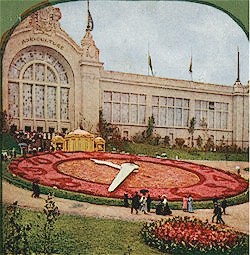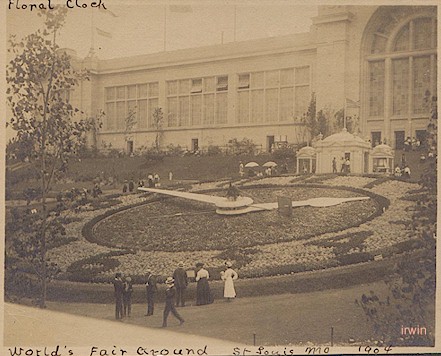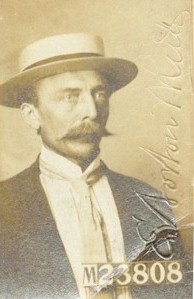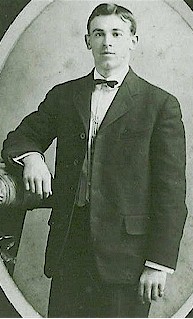Agricultural History Series
Missouri State University
1904 St. Louis Worlds Fair
The Floral Clock
In front of the Agricultural Palace on the north edge, laid on a slope, was another engineering feat of the fair. This was the only floral clock, in addition to being the largest clock in the world. In May, the surface soil was placed over what would become the dial of the large floral clock. The clock would then have 13,000 flowering plants covering its face.
The above photo is from Jackson's Photographs of the Worlds Fair and shows the north end of the Agriculture Palace. It shows the position of the Great Clock. Jackson told that the clock was illuminated by 1,000 lights. Jackson also told that the clock face was 100 feet in diameter and the figures were 15 feet high. (Photo compliments of Dan and Nathan Fortner)
This is an original photo of the great clock taken in 1904 (Irwin Collection)
Paul J. Ostrowski, a Polish youth of Milwaukee, had the distinction of being the engineer of the only floral clock in the world, and at the same time the largest clock in the world. The 112-foot floral clock announced the time to Exposition visitors from the terrace north of the Palace of Agriculture.
The engineer of this clock had to understand the complicated machinery by which the time was accurately kept. The clock was run by compressed air. The motive power came from the Exposition power house.
Mr. Ostrowski was selected because of his knowledge of the mechanism of the machinery which moved the big hands. The minute hand on the clock was 75 feet long, weighed 2,700 pounds and, moved five feet every minute. The hour hand was 50 feet long. Underneath the hands in the center of the dial was the large bronze gear mechanism which turned them. A steel shaft 4 inches in diameter, ran underneath the ground from this mechanism to a pavilion at the upper edge of and just outside of the dial circuit. This was 112 feet in diameter, where the shaft was attached to pneumatic machinery which turned it.
He also assisted in making many other different parts of the mechanism. There was a 5,000 pound bell that was struck on the hour and half hour. The bell was at the upper edge of the dial. The minute hand on the clock was 75 feet long, weighed 2,700 pounds and, moved five feet every minute. The great clock ran from 8:00 in the morning till 8:00 at night.
Sandra McManhon wrote: "My Husbands Grandfather, "Christian Bernard Mundt," was the Floral designer commissioned by Cornelli Seed Company to do the floral design incorporated in the Clock project. We have the gate pass book that allowed him passage into the fairgrounds daily along with original photographs of the clock." Click on his photo to see his pass and a good photo of the clock. Maxine Sablier Tormohlen wrote that her father, Max J. Sablier and his half Sister Rose Mossett worked in a greenhouse in Creve Coeur, MO in 1904. Maxine shared part of a letter written by her father that mentioned his working in the the Greenhouse and it also told that he planted and cared for the plants in the Great Clock at the World's Fair. Max J. Sablier was born in 1884 in Creve Coeur, MO and died in 1973 in Hanford, CA.
Maxine shared this photo of her father, Max J. Sablier.
Reference:
Worlds Fair Bulletin, August, 1904
Ingersoll Stereoview #309, 1904
Journal of Agriculture. July 21, 1904
Journal of Agriculture. June 2, 1904
Journal of Agriculture. May 12, 1904
Jackson's Photographs of the 1904 World's Fair.
This page is designed by Jeff Jackson, Sarah Williams and Ann Cavey and is maintained by Lyndon Irwin.




